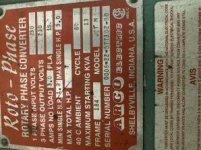US-Choppers
Plastic
- Joined
- Mar 17, 2020
240/460 motor on RPC "Cogging" & shuttering terribly at start up ENCO 13S lathe
Hi all,
I thought I would reach out to find some of you who are more electrically talented than I..... I have several machines in the shop that I run from a RPC - all of them have run flawlessly. I just brought in a really nice EMCO 13s manual lathe that I tested on site before purchasing - it was hooked up at 460 and ran like a dream. Its plate shows it as a multi voltage unit 240/400/460. I figured I would swap it over to 240 and be done. It has a real easy terminal w jumpers that are self explanatory and the manual shows the proper hookups. I did this according to the diagram I will post w my other data plates- so you can see what I have.
The problem: At start up there is incredible "cogging" for lack of a better term- the spindle shakes back and forth and it sounds like gears are being torn to pieces- I can get it to go smoothly after about 2-3 seconds - but obviously dont want to destroy this cherry lathe because of whatever issue is causing this.
It seems its in the start up circuit- Im wondering if maybe I dont have enough power in the RPC (one of the data sheets shows motor rating as 4/3- I cant imagine its a 4hp w 3hp drive?)... or perhaps I am missing something else that needs attention?
Thanks in advance for your help and input!
Best,
Rick
Hi all,
I thought I would reach out to find some of you who are more electrically talented than I..... I have several machines in the shop that I run from a RPC - all of them have run flawlessly. I just brought in a really nice EMCO 13s manual lathe that I tested on site before purchasing - it was hooked up at 460 and ran like a dream. Its plate shows it as a multi voltage unit 240/400/460. I figured I would swap it over to 240 and be done. It has a real easy terminal w jumpers that are self explanatory and the manual shows the proper hookups. I did this according to the diagram I will post w my other data plates- so you can see what I have.
The problem: At start up there is incredible "cogging" for lack of a better term- the spindle shakes back and forth and it sounds like gears are being torn to pieces- I can get it to go smoothly after about 2-3 seconds - but obviously dont want to destroy this cherry lathe because of whatever issue is causing this.
It seems its in the start up circuit- Im wondering if maybe I dont have enough power in the RPC (one of the data sheets shows motor rating as 4/3- I cant imagine its a 4hp w 3hp drive?)... or perhaps I am missing something else that needs attention?
Thanks in advance for your help and input!
Best,
Rick
Attachments
Last edited:

















